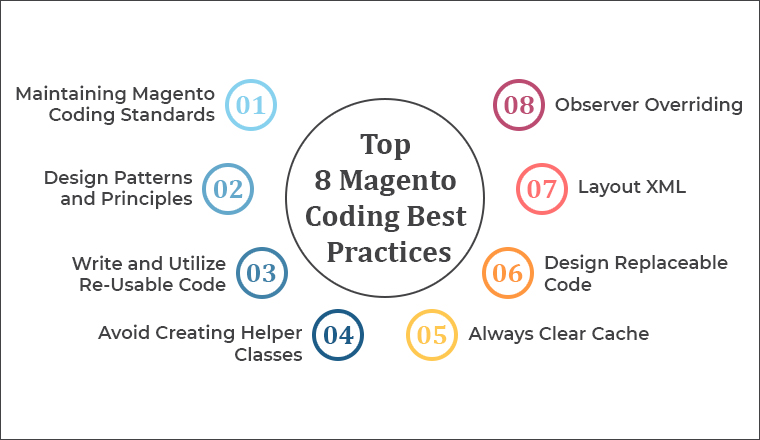Top 8 Magento Coding Best Practices
Will you believe if we say that Magento has the power to amplify your sales by 2.5 times than existing ways? Yes, leading online businesses have stated in surveys and research that if they are running an eCommerce business, their success attribute is highly praised by Magento amounting to some 10–80% of their overall revenue. The potential of Magento is massively unpredictable, so small retail businesses to large enterprises want to take advantage of this leading eCommerce platform. Magento as technology adds numerous users to the store, manages coupons, integrates various payment methods, adds security seals, and more using third-party modules.
However, when integrating third-party extensions into a Magento store, there are several recommended best practices that should always be followed by Magento developers in India. These best practices can help you reduce the number of issues in your core code while also improving the quality and upkeep of Magento source code. Let us see in this blog, how adhering to basic Magento coding best practices can help businesses build simpler and clear concepts.
1. Magento Coding Best Practices

1.1 Maintaining Magento Coding Standards
The Magento Coding Standard is almost every company’s official coding standard. It works in conjunction with other standardized tools which include PHP CodeSniffer, implementing not just standard PHP recommendations like PSR compliance, basic security rules, and syntax checks, but also Magento-specific changes like naming conventions and other coding standards.
As a result, most developers frequently work under tight deadlines, causing them to disregard coding standards. While it fulfills its function in the short term, the situation worsens over time. Your Magento code will be prone to errors and complex upgrades if you do not follow the coding standards. The performance of the code is also influenced by a lack of quality.
The Magento Coding Standard is also used for automatic evaluations of Magento Marketplace modules and compatibility with Magento instances operating on the Magento Cloud. Following these coding principles will improve the quality of your code as well as its interoperability with the Magento ecosystem.
1.2 Design Patterns and Principles
The next step in the best practices section includes many critical steps related to the design of an eCommerce store. This will apply to many programming languages and frameworks, not just Magento and PHP. You as a business can follow your own way of designing. Although, there are a number of common design patterns and concepts to follow that are widely acknowledged as best coding practices.
In this process, you can take resources from the best source-making websites. Such pages are a good source for learning about different design patterns. For source patterns, there are many set sample design patterns and examples. Some sources are tried-and-tested true patterns of sound programming principles that may be applied to almost any programming project. Best practices for design patterns may evolve over time, but they tend to remain consistent.
1.3 Write and Utilize Re-Usable Code
Reusing code as much as feasible is considered one of the basic thumb rules. One of the most vital coding best practices is to avoid duplicating codes to stop the use of redundant code. This is because such codes are difficult to maintain and it also occupies more space on your web server. Redundant or duplicate code often creates confusion. In this, you can create a single class or function and refer to it as needed, rather than copying and pasting the same code again and again.
Small and focused code that provides a generic solution should be written. You’ll be able to reuse code in future projects as a result of this.
1.4 Helper Classes Make no Difference
In this process of creating web applications, there are helper classes that also play a major role in streamlining the development process. The term “helper class” or “utility class” refers to classes with static methods that don’t belong in any other place. When you use such classes, they defy OOPS (object-oriented programming concepts) and their antipatterns. Because it tries to handle various functions in a single class, a helper class that acts as a catch-all for random methods violates the single responsibility principle.
Such static functions in helper or utility classes are exclusive to those types and cannot be utilized in other classes. The static methods of a helper class, on the other hand, may usually be refactored into a function for another class. This is a good strategy since it results in object-oriented code.
Furthermore, by including several functions to tackle different problems, the helper class eliminates the idea of single responsibility. As a result, the code should be designed in such a way that each class only contains the functions that are relevant for that appropriate class.
1.5 Clearing Cache is Very Important
Caching is one of the biggest practices that one must follow in Magento development. Caching is considered one of the most challenging aspects that obstruct the development process. It becomes unreliable when the codes displayed are retrieved from the cache. So, from a Magento 2 development perspective, this is quite vital to clear cache and deliver legit results.
As Magento 2 has so many components such as modules, classes, themes, and language packages, it’s very clear to clean the cache. If you do not clear the cache, the code will not operate properly and the web developer will be confused.
1.6 Designing a Replaceable Code
As long as you want to sound efficient, it is important to make use of codes that are apt to be reusable. You as a business can easily design replaceable code as it will help you to make things reusable. By creating replaceable code, you are free to make it modular and loosely connected, and this will allow you to easily make future development changes and modifications.
Reusable codes are a new practice to work faster and deliver desired results on time. As new issues are discovered or new tactics become available, it should be standard practice to update your present Magento’s codebase with newer and better code components.
1.7 Layout XML
Magento 2 has updated its layout definition to a more advanced one to restrict the modifications you can do in template files which were possible in the previous version. With new additions to a container, you can start to move the reference Block, reference container, move, update, and argument tags the complete definition for layout XML results
1.8 Observer Override Layout
Observers are dynamically introduced into the execution flow, they can change the behavior of a Magento website. Poorly designed and programmed observers can create problems, instability, and even application failure.
However, simply ensuring that the observer’s code is good enough is insufficient. The following pointers can help your Magento application’s observer work well.
The observer’s performance can be improved by avoiding complicated computations in its code. Efficiency will be critical, especially in situations when the observer is regularly listening to a dispatched event. If sophisticated computations are used, the observer will slow down, which will slow down the web application.
Another typical blunder is to include unneeded logic in the observer code. The observer’s classes should only contain business logic.
2. Conclusion
Every best practice will take you and your business a step ahead of where you need to be. It will take on a completely new path with better business results. So, in case you want to lead your business and take a super lead, following the above-mentioned Magento coding best practices is ideal. Maintaining a good standardized code and adhering to best practices will make your Magento code even stronger. You would not have to rely on helper classes, just follow some basic steps and you are all set to achieve desired business results.

Hardik Dhanani has a strong technical proficiency and domain expertise which comes by managing multiple development projects of clients from different demographics. Hardik helps clients gain added-advantage over compliance and technological trends. He is one of the core members of the technical analysis team.
PHP is a forgiving language which means that like JavaScript, it enables the web developers not to define variable types and this leads to errors...
 Aug 8, 2022
Aug 8, 2022 



To be honest, I expected more from this blog but It didn't live up to my expectations. You did mention some common Magento best practices. There are more best practices that you can add to this blog. I hope you update this blog in the future. Thanks!
Worth reading your blog. I just love the way you demonstrated Magento coding best practices. I have been searching for this type of resource for a while.